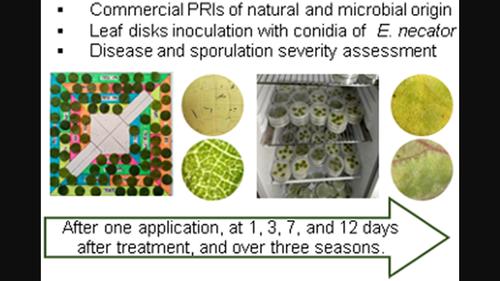抗性诱导剂对葡萄白粉病的感染前功效
IF 2.4
3区 农林科学
Q1 AGRONOMY
引用次数: 0
摘要
植物抗性诱导剂(PRIs)在可持续葡萄栽培的病害控制中越来越受到关注,但其在葡萄园中的功效仍在研究之中。我们研究了四种天然和微生物来源的商业 PRI 对葡萄叶片白粉病(PM)发展的影响,为期 3 年。在处理后 1、3、7 和 12 天(DAT),在 PRI 处理过的叶片上人工接种新白粉病菌分生孢子后,对病害和孢子的严重程度进行了评估。在降低病害(分别为 57.1% 和 49.5%)和孢子化(分别为 85.3% 和 90.2%)严重程度方面,氨基甲酸乙酯(LAM)和复方阿糖胞苷(COS)的效果最好;谷维素(CER)对 PM 严重程度的降低率较低(27%),而寡糖百菌清(PYT)的降低率介于两者之间(44.9%)。LAM 从 1 DAT 开始有效,而 COS 和PYT 在 7 至 12 DAT 接种 E. necator 时更有效。这些结果为如何将 PRIs 用作坏死杆菌感染前 1 到 3 天的单一预防性干预措施提供了新的视角,具体取决于所使用的产品。PRIs 对坏死杆菌菌落孢子化的影响还表明,它对 PM 流行病的影响范围更广、时间更长。本文章由计算机程序翻译,如有差异,请以英文原文为准。

Pre‐infection efficacy of resistance inducers against grapevine powdery mildew
Plant resistance inducers (PRIs) are of increasing interest for disease control in sustainable viticulture, but their efficacy in vineyards is still under investigation. We studied the effects of four commercial PRIs, of natural and microbial origin, on the development of powdery mildew (PM) on grapevine leaves over a 3‐year period. Disease and sporulation severity were evaluated following the artificial inoculation of PRI‐treated leaves with Erysiphe necator conidia at 1, 3, 7 and 12 days after treatment (DAT). Laminarin (LAM) and cos‐oga (COS) were the most effective in reducing both disease (57.1% and 49.5%, respectively) and sporulation (85.3% and 90.2%, respectively) severity; the reduction in PM severity provided by cerevisane (CER) was lower (27%), and that of Pythium oligandrum (PYT) was intermediate (44.9%). LAM was effective from 1 DAT, while COS and PYT were more effective when E . necator was inoculated at 7 to 12 DAT. These results open new perspectives on how PRIs are used as single, preventative interventions performed 1 to 3 days before E . necator infection, depending on the product used. The effect of PRIs on the sporulation of E . necator colonies also suggests a broader and longer effect on PM epidemics.
求助全文
通过发布文献求助,成功后即可免费获取论文全文。
去求助
来源期刊

Plant Pathology
生物-农艺学
CiteScore
5.60
自引率
7.40%
发文量
147
审稿时长
3 months
期刊介绍:
This international journal, owned and edited by the British Society for Plant Pathology, covers all aspects of plant pathology and reaches subscribers in 80 countries. Top quality original research papers and critical reviews from around the world cover: diseases of temperate and tropical plants caused by fungi, bacteria, viruses, phytoplasmas and nematodes; physiological, biochemical, molecular, ecological, genetic and economic aspects of plant pathology; disease epidemiology and modelling; disease appraisal and crop loss assessment; and plant disease control and disease-related crop management.
 求助内容:
求助内容: 应助结果提醒方式:
应助结果提醒方式:


